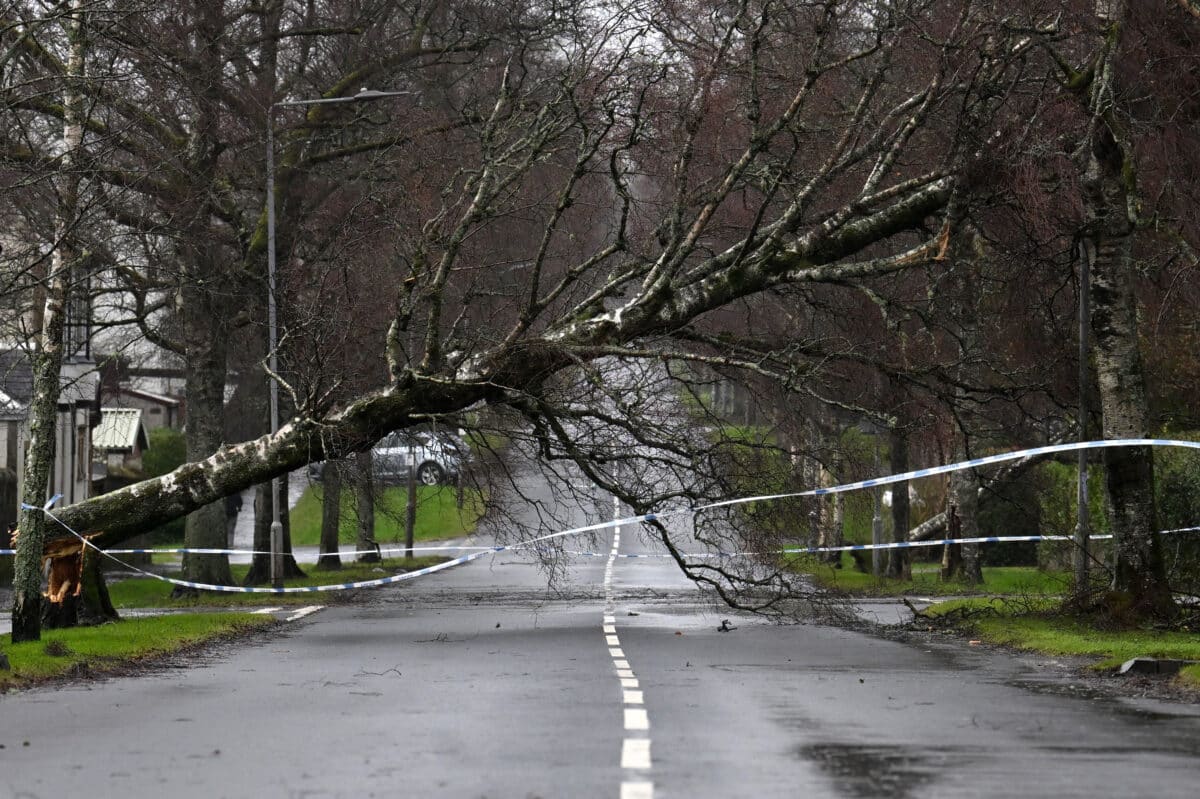Power cuts, transport chaos as Storm Eowyn hits Ireland, UK

A photograph taken on January 24, 2025 shows a fallen tree obstructing a road in Helensburgh, Scotland as Storm Eowyn brings winds of 100 mph to the UK and Ireland. A rare red warning for wind, which warns of “very dangerous conditions” and gusts of up to 100mph, was issued by the Met Office for Northern Ireland and Scotland on Friday. (Photo by ANDY BUCHANAN / AFP)
DUBLIN, Ireland — Storm Eowyn caused havoc Friday as it battered Ireland, Northern Ireland and Scotland, killing one person and leaving hundreds of thousands of homes without power, flights grounded and schools shut, officials said.
Millions of people across the three nations were urged to shelter at home from the “destructive” storm as Ireland recorded its strongest-ever wind gusts. One man died in Ireland when a tree fell on his car, police said.
Gusts of 183 kilometers (114 miles) per hour — breaking an 80-year-old record — brought down power lines, felled trees, blocked roads, and destroyed two Irish sports facilities.
By evening, the highest-level red warning had been lifted in Ireland and Scotland, but authorities still called for vigilance.
“It is so important that people follow… advice not to travel because if people stay at home and don’t travel then it means they don’t invite that risk to themselves,” Scotland’s deputy first minister Kate Forbes told BBC radio.
Scotland, Ireland, and Northern Ireland closed schools and canceled trains, flights, and ferries.
After winds eased, Dublin Airport — which had earlier announced that airlines had canceled more than 120 scheduled departures and 110 arrivals — said its first flight took off at around 0930 GMT.
Flights were also canceled at other airports, including Belfast in Northern Ireland and Aberdeen, Edinburgh and Glasgow in Scotland.
Damage in Ireland included the destruction of an ice-skating rink near Dublin and a multi-million-pound indoor games facility in western County Mayo after winds ripped through them.
Cathriona Heffernan, 25, from Galway City in Ireland, described the winds as “crazy” even in the early stages of the storm, adding that five 60-year-old trees had been uprooted.
“One of them split right in half, so it’s scary to think just how strong the wind was to be able to do that,” she said.
Satellite imagery suggested a dangerous weather phenomenon known as a sting jet had developed over Ireland on Friday morning, the Met Office said.
A sting jet is a small area of very intense winds, which can be as strong as 160 kilometers per hour or more, it said.
The same type of extreme weather event was the cause of England’s “Great Storm” in October 1987, which claimed 18 lives.
‘Dangerous and destructive’
In Ireland, 715,000 homes and businesses were without power while in Northern Ireland, over 93,000 were hit by outages, electricity suppliers said.
The highest wind speed recorded in Britain on Friday was 149 kilometers per hour at Brizlee Wood in Northumberland in northeast England, according to the Met Office.
The strongest gust ever recorded in the UK is 228 kilometres per hour at Fraserburgh in eastern Scotland, on February 13, 1989.
Irish forecaster Met Eireann said on X the previous record in Ireland was 182 kilometers per hour, recorded in 1945.
Northern Ireland Electricity Networks said Storm Eowyn was causing “widespread damage” to the electricity network.
“We anticipate we will begin assessing the damage to the network after 2:00 pm once the red weather warning has been lifted,” it said in a statement.
In Scotland over 22,000 homes were without electricity as fallen trees and debris damaged power lines.
Hundreds of schools were closed for the day and train operator ScotRail suspended all services. Many rail routes in northern England were also axed.
Britain’s environment agency warned of flooding in southern and central England over the coming days.
Ahead of the storm, some 4.5 million people on Thursday received emergency alerts on their phones, the “largest real-life use of the tool to date” on Thursday, the UK government said.
Scientists have shown that climate change caused by humans burning fossil fuels is making storms more severe and super-charged by warmer oceans.
Storms, however, are natural phenomena and to date, no specific scientific attribution to climate change has been made for this storm.